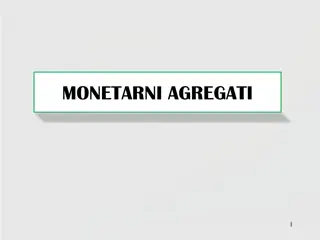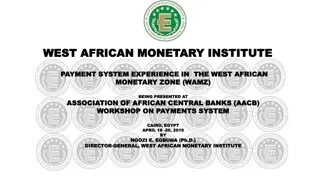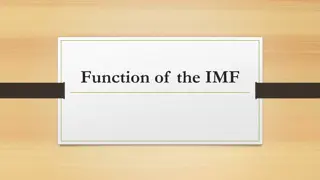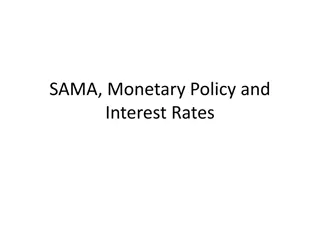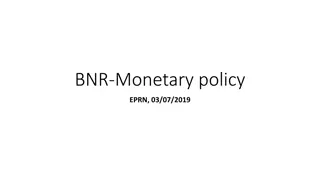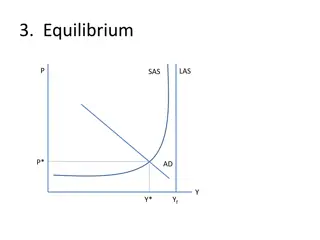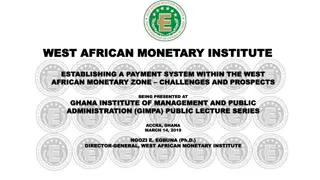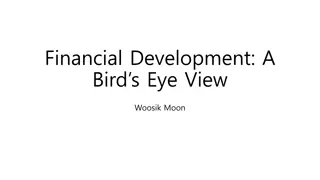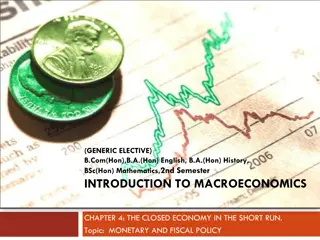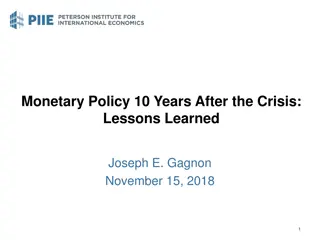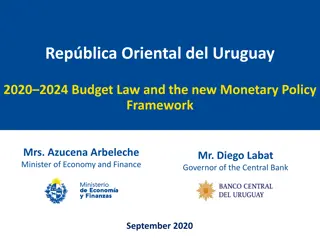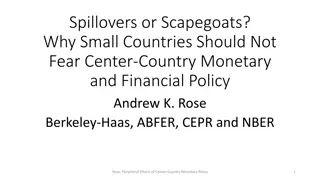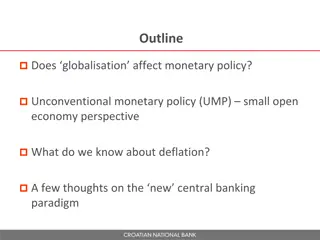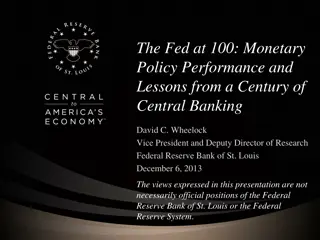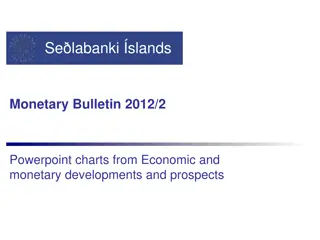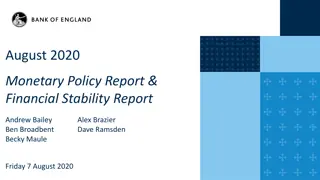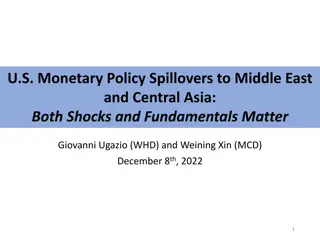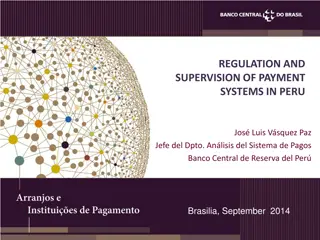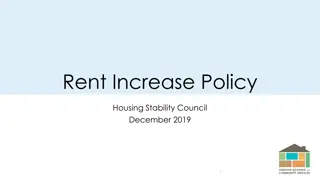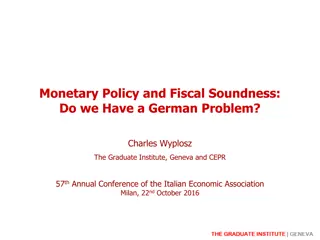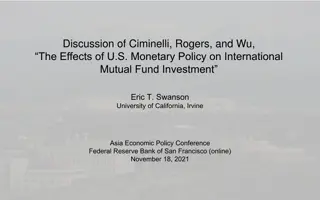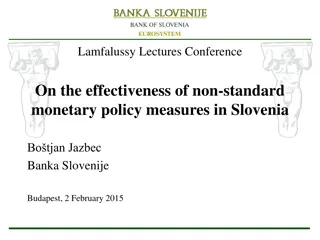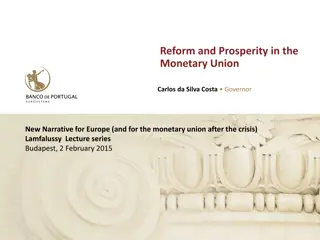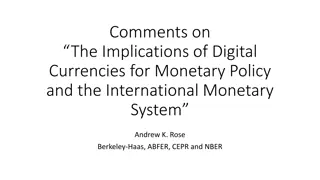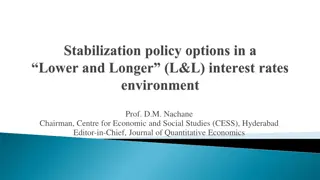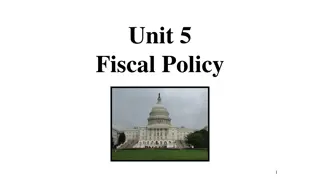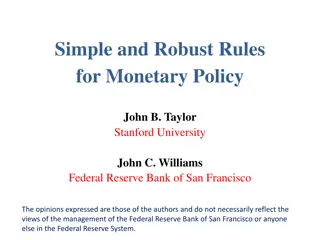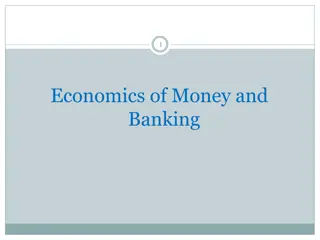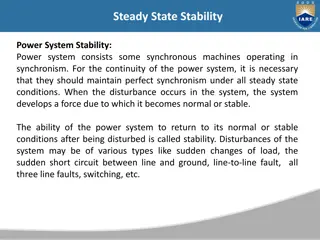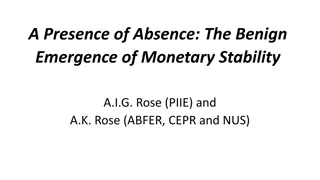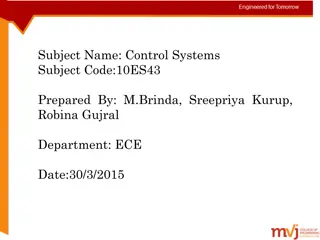Role of Central Banks in International Financial Institutions
Central banks play a crucial role in the interconnectivity with international financial institutions like the Asian Development Bank (ADB) and the International Monetary Fund (IMF). These institutions aim to promote economic and social development, ensure exchange rate stability, provide financial a
1 views • 18 slides
Benefits of Coordinating Monetary Transfers for Beneficiaries
Coordinating monetary transfers provides various advantages for beneficiaries, including scalability, increased resources, speed, reduced duplication, improved targeting, better referral networks, enhanced links with social protection systems, improved communication, and harmonized approaches. This
4 views • 16 slides
Understanding Quantitative Credit Control Methods in RBI's Monetary Policy
RBI's monetary policy revolves around maintaining credit quantity in the market through quantitative credit control methods. This includes Bank Rate Policy, Open Market Operations, Cash Reserve Ratio (CRR), and Statutory Liquidity Ratio (SLR). These tools help regulate credit flow, liquidity, and ma
4 views • 8 slides
Overview of Monetary Aggregates in Bosnia and Herzegovina
Image descriptions and explanations about monetary aggregates, money as a payment instrument, cash in circulation, deposit money, M1, M2, M3 categories, and monetary base. Additionally, details on net foreign assets, net reserves, and changes in monetary policy affecting currency board arrangements
1 views • 17 slides
Development of West African Monetary Institute Payment System
The West African Monetary Institute (WAMI) has been instrumental in establishing a payment and settlement system within the West African Monetary Zone (WAMZ). The institute's efforts have focused on promoting cross-border transactions and economic integration among member countries, with the ultimat
0 views • 46 slides
The Functions of the IMF: Regulatory, Financial, Consultative
The International Monetary Fund (IMF) has several functions, including regulatory oversight, financial support for member countries facing balance of payments deficits, and providing consultative guidance. These functions are crucial in ensuring stability in the international monetary system. The IM
1 views • 6 slides
Saudi Arabian Monetary Agency (SAMA) Overview
The Saudi Arabian Monetary Agency (SAMA) serves as the central bank of Saudi Arabia with a focus on managing the country's monetary policy, maintaining price stability, and supervising financial institutions. Established in 1952, SAMA's functions include managing the national currency, foreign excha
0 views • 24 slides
Understanding Money and Monetary Policy in Economics
Money serves as a medium of exchange, store of value, and unit of account in an economy. It is vital for economic transactions and stability. The quantity of money is measured using concepts like liquidity and monetary aggregates. The demand for money is linked to the Quantity Theory of Money, which
2 views • 12 slides
Understanding Economic Policies: Monetary and Fiscal Approaches
Explore the dynamics of economic equilibrium, aggregate demand, and supply while delving into the effectiveness of monetary and fiscal policies. Learn about strategies to tackle inflation and unemployment through contractionary and expansionary measures, and how crowding out can impact the economy.
0 views • 9 slides
Challenges and Prospects of Establishing a Payment System in the West African Monetary Zone
The West African Monetary Zone (WAMZ) is striving to create a zonal payment and settlement system for cross-border transactions, aiming at economic integration for a common central bank and single currency. This initiative faces challenges but also holds promising prospects for regional financial in
3 views • 46 slides
Understanding Economic and Monetary Policies in Korea and Worldwide
This course provides an insightful exploration of major policy issues related to money, banking, and financial development globally and in Korea. It covers the goals and conduct of economic and monetary policies, the impact of money on economies, financial stability, and responses to depression and
1 views • 25 slides
Poverty Measurement in Mauritius: An Overview of Monetary and Non-Monetary Approaches
The measurement of poverty in Mauritius involves multidimensional assessments using both monetary and non-monetary approaches. The country's national priorities include poverty eradication, improving well-being, and ensuring inclusive growth. The monetary approach assesses poverty based on the Relat
1 views • 12 slides
Macroeconomic Policy Tools: Monetary and Fiscal Policy in Short Run
This chapter delves into the IS-LM model to illustrate the functioning of monetary and fiscal policies in influencing economic growth. It explains how these policies impact output, interest rates, and inflation rates in a closed economy in the short run. Monetary policy mainly operates through open
0 views • 18 slides
Monetary Policy 10 Years After the Crisis: Lessons Learned
Explore the evolution of monetary policy post-crisis, including definitions of monetary and fiscal policies, liquidity traps, and the Federal Reserve's actions during the Great Recession. Key lessons learned emphasize the importance of countercyclical policies, effective use of quantitative easing (
0 views • 8 slides
Economic Recovery and Fiscal Stability in Uruguay: Budget Law and Monetary Policy Framework 2020-2024
The Budget Law and Monetary Policy Framework in Uruguay for 2020-2024 focus on restoring fiscal consolidation, stabilizing debt, and implementing market-friendly policies for economic recovery. Successful COVID-19 containment strategies have allowed for a faster normalization of economic activity. L
2 views • 35 slides
Understanding Aircraft Stability and Manoeuvrability
Exploring the principles of flight, this content covers how the stability of an airplane is maintained, the forces involved in aircraft motion, and stability objectives related to different axes of rotation and planes of movement. It also delves into the effects of dihedral and anhedral on stability
1 views • 45 slides
Understanding Ship Stability: Centre of Gravity and Metacentre
Exploring the concepts of transverse statical stability, centre of gravity, centre of buoyancy, metacentre, stable equilibrium, unstable equilibrium, and neutral equilibrium in ship stability. The relationship between these key points determines a ship's stability and ability to maintain a steady po
0 views • 8 slides
Small Countries' Resilience Against Center-Country Monetary Policies
Small countries should not fear the monetary and financial policies of larger center countries. This article discusses the potential spillovers of unconventional monetary policies by center countries, such as quantitative easing and negative nominal interest rates. It explores the concept of currenc
0 views • 39 slides
Globalisation's Impact on Monetary Policy and Central Banking Paradigm
Globalisation has reshaped monetary policy dynamics, influencing inflation pressures and the transmission of shocks across economies. Unconventional monetary policies in small open economies have challenged conventional theories, highlighting the complexity of managing monetary conditions. The inter
0 views • 24 slides
Evolution of Monetary Policy and Financial Stability: Lessons from the First 100 Years of the Federal Reserve
The Federal Reserve's journey over a century reflects the evolution of monetary policy and financial stability. From its founding to responses to crises like the Great Depression and Great Recession, the Fed's policies have adapted to changing economic landscapes. Understanding these historical even
0 views • 20 slides
Design for Stability - Direct Analysis Method CE 470 (Fall 2016) Saahastaranshu R. Bhardwaj
Stability in structural design is crucial for the safety and performance of compression members, elements, and frames. This content focuses on the Direct Analysis Method (DAM) as a rational approach to considering stability in structural engineering. Factors influencing stability, second-order effec
1 views • 29 slides
Economic and Monetary Developments Outlook Presentation 2012/2
This presentation provides insights into the economic and monetary developments and prospects in Iceland as per the Monetary Bulletin of 2012/2. It includes charts depicting the economic outlook and key uncertainties faced by the region. The slides offer a comprehensive overview of the current econo
0 views • 84 slides
August 2020 Monetary Policy Report & Financial Stability Report Highlights
In the August 2020 Monetary Policy Report & Financial Stability Report, key officials like Andrew Bailey, Ben Broadbent, and others discuss the economic projections, conditioning assumptions, and near-term forecasts. The report outlines the uncertainties caused by the pandemic and Brexit, highlighti
0 views • 26 slides
U.S. Monetary Policy Spillovers to Middle East and Central Asia: Shocks and Fundamentals Impact
The research explores the impact of U.S. monetary policy spillovers on the Middle East and Central Asia regions, focusing on shocks and country fundamentals. It examines historical data, model analysis, and the 2022 tightening effects. The study reveals that both contractionary monetary policy shock
0 views • 20 slides
Regulation and Supervision of Payment Systems in Peru
Peru has seen significant economic growth and stability from 2004 to 2013, enhancing confidence in the payment system. The Central Reserve Bank of Peru plays a crucial role in ensuring systemic stability, oversight, and efficiency in payment systems. Supervision is necessary to safeguard public obje
0 views • 24 slides
Advanced Solutions for Concrete Dam Assessment
Utilizing advanced methods for the assessment of existing concrete dams is crucial for ensuring their stability and safety. This project focuses on analyzing the stability of small concrete dams in Norway built between 1950-1970, which may not meet current safety standards. The study involves evalua
0 views • 12 slides
Rent Increase Policy Overview by Housing Stability Council
The Rent Increase Policy established by the Housing Stability Council aims to balance financial sustainability with resident stability in affordable housing. The policy allows for rent increases up to 5%, with reviews required for higher increases. Stakeholder feedback, unique market conditions, and
1 views • 11 slides
Challenges and Solutions in Eurozone Monetary Policymaking
Addressing the issues within the Eurozone monetary policy framework, the article explores concerns related to fiscal soundness, output gaps, and the role of countries like Germany. It emphasizes the need for tailored approaches, fiscal discipline, and potential reforms to achieve stability and growt
0 views • 10 slides
Understanding the Effects of U.S. Monetary Policy on International Mutual Fund Investment
This paper discusses the impact of U.S. monetary policy shocks on international mutual fund flows, distinguishing between pure monetary policy shocks and information shocks. It examines how these shocks influence mutual fund investments and explores the differences in reactions to the Federal Reserv
0 views • 9 slides
Challenges and Solutions in Implementing Non-Standard Monetary Policies in Slovenia
The decoupling of real and financial cycles in Slovenia, attributed to a balance-sheet recession and unsustainable debt-financed growth, poses challenges for monetary policy effectiveness. Credit decline persists despite economic growth, hindered by risk-averse banks and limited market for alternati
0 views • 14 slides
Reform and Prosperity in the Monetary Union: A Path to Sustainable Growth
The lecture series highlights the symbiotic relationship between the Monetary Union and economic growth, emphasizing the need for sustainable economic policies at both national and European levels. It discusses the role of Monetary Union in facilitating sustainable development while addressing the c
0 views • 9 slides
Insights on Digital Currencies: Implications for Monetary Policy and the International System
Reflecting on the implications of digital currencies for monetary policy and the international monetary system, the comments by Andrew K. Rose highlight potential effects on capital mobility, currency substitution, and the evolution of money. Emphasizing the small size of cryptocurrencies compared t
0 views • 18 slides
Challenges and Alternatives in Monetary Policy During Economic Depressions
The zero lower bound (ZLB) poses challenges to conventional monetary policy during severe depressions, leading to prolonged periods of low interest rates. Mainstream macroeconomic theory falls short in providing effective guidance, prompting the exploration of alternate mechanisms such as taxation,
0 views • 29 slides
Understanding Government Tools for Economic Stability
The government uses fiscal and monetary policies to stabilize the economy. Fiscal policy involves Congress's actions through government spending or taxation changes, while monetary policy is driven by the Federal Reserve Bank. Discretionary fiscal policy involves new bills designed to adjust aggrega
0 views • 36 slides
Simple and Robust Rules for Monetary Policy Overview
This document discusses the historical background, empirical experience, characteristics of simple rules, robustness, and the comparison between optimal control and simple rules in monetary policy. It explores the evolution of policy rules from Smith and Ricardo to modern approaches, emphasizing the
0 views • 22 slides
Understanding Economics of Money and Banking
This course delves into monetary theories, the financial system, bank management, and regulation. The aim is to provide a comprehensive understanding of monetary policy, financial systems, and their impact on the economy. Through interactive lectures and discussions, students will grasp the fundamen
0 views • 30 slides
Understanding Power System Stability: Synchronous Machines and Dynamics
Power system stability is crucial for maintaining synchronism and continuity. It includes steady-state and transient stability, with dynamics of synchronous machines playing a key role. Different types of disturbances can affect stability, requiring a system's ability to adjust and return to normal
0 views • 73 slides
The Emergence of Monetary Stability in a Changing Economic Landscape
Amidst global economic shifts, A.I.G. Rose and A.K. Rose explore the emergence of monetary stability in their publication "A Presence of Absence." They delve into the rise of effective monetary policies, the impact of inflation targeting, and the evolution of stable monetary regimes. Through insight
0 views • 36 slides
Stability Analysis in Control Systems
Stability analysis in control systems is crucial for ensuring the predictability and reliability of system responses. It involves assessing various stability criteria such as Routh Stability Criterion and investigating the behavior of systems under different conditions like bounded inputs. Understan
0 views • 29 slides
Campaign Planning Update: Academic Senate, January 24, 2017
This update covers the campaign planning process at the Academic Senate, focusing on objectives, volunteer engagement, monetary goals, nucleus fund details, non-monetary goals, and next steps. Key highlights include identifying cross-cutting themes, engaging faculty and volunteers, setting a monetar
0 views • 9 slides



